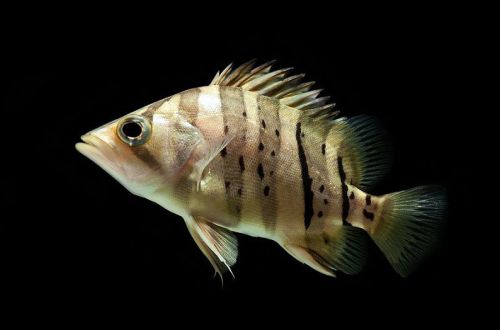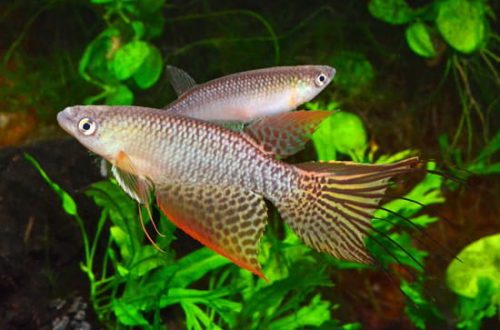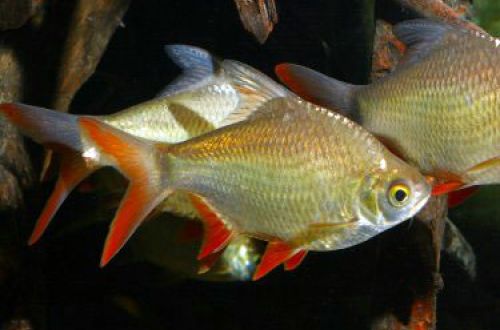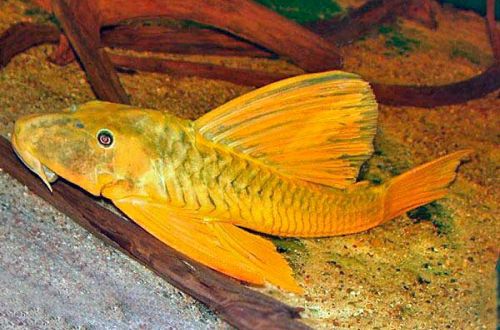
tiger perch
Siamese tiger perch or Indonesian tiger perch, scientific name Datnioides microlepis, belongs to the Datnioididae family. Large predatory fish with bright contrasting coloration. Despite the status of a predator, it can be kept with other large fish in a common aquarium. Maintenance requires no small financial costs due to the need to purchase a large aquarium and expensive equipment.

Contents
Habitat
It originates from Southeast Asia from the Malay Peninsula, where it is found in the river systems of Perak (Sungai Perak) and Selangor (Selangor River), as well as in the western part of Indonesia on the islands of Sumatra and Borneo. It lives in large deep rivers flowing through flat terrain. During the rainy season, as the water level rises, it swims into flooded areas of tropical forests.
Brief information:
- The volume of the aquarium – from 600 liters.
- Temperature – 22-26°C
- Value pH — 6.5–7.5
- Water hardness – soft to medium hard (2-15 dGH)
- Substrate type – any
- Lighting – moderate
- Brackish water – no
- Water movement – weak, moderate
- The size of the fish is up to 50 cm.
- Nutrition – fresh meat and live food
- Temperament – conditionally peaceful
- Content solitary together with other species
Description
Adult individuals reach a length of about 50 cm. Sexual dimorphism is weakly expressed, there are no obvious differences between male and female. The fish has a swift body shape. The large head is pointed, the silhouette resembles an arrowhead. The dorsal fin is a ridge that extends to the tail. The anal fin is located closer to the end of the body and is directed towards the tail. Thus, the fins, together with the tail, provide the rapid acceleration needed to capture prey. The coloration is yellow with diagonal black stripes. A similar body pattern is reflected in the name – “Tiger Perch”.
Food
A true predator, in nature hunts for smaller fish. In a home aquarium, fry and juveniles can eat bloodworms, brine shrimp, small earthworms, and pieces of shrimp. Adults will need live fish. As an alternative, pieces of meat from other fish, large earthworms, whole shrimp, mussels, etc. are suitable. Feed once every 1-2 days, but with a delivery amount of food, or daily, but in small portions.
Maintenance and care, arrangement of the aquarium
Aquarium sizes for one fish start from 600 liters. The design uses clusters of floating plants and various snags that serve as a place to hide. In nature, the Indonesian tiger perch prefers such places to hide in the thickets and ambush their prey. The rest of the decorative elements and the soil is chosen at the discretion of the aquarist. It is advisable to keep open spaces for swimming.
Successful keeping is possible only in an aquarium equipped with a productive filtration system and other equipment that ensures and controls the quality and composition of water. Mandatory maintenance procedures are weekly replacement of part of the water (15–25% of the volume) with fresh water and regular cleaning of organic waste.
For beginner aquarists, it is advisable to entrust the installation and connection of the aquarium to professionals.
Behavior and Compatibility
Young perches are kept in groups, but as they grow older they become loners and do not like relatives in their territory too much, so adult fish should be kept separately. Compatible with other non-aggressive species of comparable size. You should not settle too small fish, which can become part of the diet of the Siamese tiger bass, as well as overly active and territorial.
Breeding / breeding
Successful cases of breeding this species in aquariums have not been recorded. For sale are supplied from commercial fish farms or caught from the wild.
Fish diseases
Hardy and unpretentious fish. In favorable conditions, diseases are rare and are associated mainly with difficulties in acclimatization. Read more about symptoms and treatments in the Aquarium Fish Diseases section.





